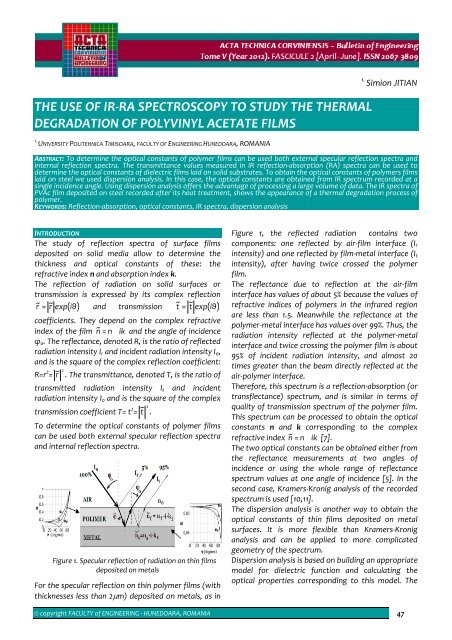Editorial & Advisory Board - Acta Technica Corviniensis
Editorial & Advisory Board - Acta Technica Corviniensis
Editorial & Advisory Board - Acta Technica Corviniensis
Create successful ePaper yourself
Turn your PDF publications into a flip-book with our unique Google optimized e-Paper software.
THE USE OF IR‐RA SPECTROSCOPY TO STUDY THE THERMAL<br />
DEGRADATION OF POLYVINYL ACETATE FILMS<br />
1.<br />
UNIVERSITY POLITEHNICA TIMISOARA, FACULTY OF ENGINEERING HUNEDOARA, ROMANIA<br />
1.<br />
Simion JITIAN<br />
ABSTRACT: To determine the optical constants of polymer films can be used both external specular reflection spectra and<br />
internal reflection spectra. The transmittance values measured in IR reflection‐absorption (RA) spectra can be used to<br />
determine the optical constants of dielectric films laid on solid substrates. To obtain the optical constants of polymers films<br />
laid on steel we used dispersion analysis. In this case, the optical constants are obtained from IR spectrum recorded at a<br />
single incidence angle. Using dispersion analysis offers the advantage of processing a large volume of data. The IR spectra of<br />
PVAc film deposited on steel recorded after its heat treatment, shows the appearance of a thermal degradation process of<br />
polymer.<br />
KEYWORDS: Reflection‐absorption, optical constants, IR spectra, dispersion analysis<br />
INTRODUCTION<br />
The study of reflection spectra of surface films<br />
deposited on solid media allow to determine the<br />
thickness and optical constants of these: the<br />
refractive index n and absorption index k.<br />
The reflection of radiation on solid surfaces or<br />
transmission ~ is expressed by its complex reflection<br />
~<br />
~ ~<br />
r = r exp( iθ)<br />
and transmission t = t exp ( iθ )<br />
coefficients. They depend on the complex refractive<br />
index of the film n ~ = n ik and the angle of incidence<br />
φ 0 . The reflectance, denoted R, is the ratio of reflected<br />
radiation intensity I r and incident radiation intensity I 0 ,<br />
and is the square of the complex reflection coefficient:<br />
R=r 2 2<br />
=<br />
~<br />
r . The transmittance, denoted T, is the ratio of<br />
transmitted radiation intensity I t and incident<br />
radiation intensity I 0 and is the square of the complex<br />
transmission coefficient T= t 2 ~ 2<br />
= t .<br />
To determine the optical constants of polymer films<br />
can be used both external specular reflection spectra<br />
and internal reflection spectra.<br />
Figure 1. Specular reflection of radiation on thin films<br />
deposited on metals<br />
For the specular reflection on thin polymer films (with<br />
thicknesses less than 2μm) deposited on metals, as in<br />
Figure 1, the reflected radiation contains two<br />
components: one reflected by air‐film interface (I r<br />
intensity) and one reflected by film‐metal interface (I t<br />
intensity), after having twice crossed the polymer<br />
film.<br />
The reflectance due to reflection at the air‐film<br />
interface has values of about 5% because the values of<br />
refractive indices of polymers in the infrared region<br />
are less than 1.5. Meanwhile the reflectance at the<br />
polymer‐metal interface has values over 99%. Thus, the<br />
radiation intensity reflected at the polymer‐metal<br />
interface and twice crossing the polymer film is about<br />
95% of incident radiation intensity, and almost 20<br />
times greater than the beam directly reflected at the<br />
air‐polymer interface.<br />
Therefore, this spectrum is a reflection‐absorption (or<br />
transflectance) spectrum, and is similar in terms of<br />
quality of transmission spectrum of the polymer film.<br />
This spectrum can be processed to obtain the optical<br />
constants n and k corresponding to the complex<br />
refractive index n ~ = n ik [7].<br />
The two optical constants can be obtained either from<br />
the reflectance measurements at two angles of<br />
incidence or using the whole range of reflectance<br />
spectrum values at one angle of incidence [5]. In the<br />
second case, Kramers‐Kronig analysis of the recorded<br />
spectrum is used [10,11].<br />
The dispersion analysis is another way to obtain the<br />
optical constants of thin films deposited on metal<br />
surfaces. It is more flexible than Kramers‐Kronig<br />
analysis and can be applied to more complicated<br />
geometry of the spectrum.<br />
Dispersion analysis is based on building an appropriate<br />
model for dielectric function and calculating the<br />
optical properties corresponding to this model. The<br />
© copyright FACULTY of ENGINEERING ‐ HUNEDOARA, ROMANIA 47

















